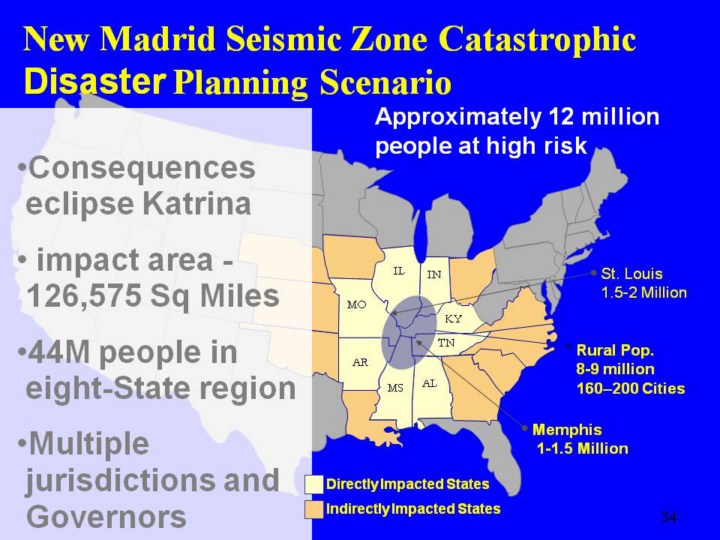| front |1 |2 |3 |4 |5 |6 |7 |8 |9 |10 |11 |12 |13 |14 |15 |16 |17 |18 |19 |20 |21 |22 |23 |24 |25 |26 |27 |28 |29 |30 |31 |32 |33 |34 |35 |36 |37 |38 |39 |40 |41 |42 |43 |44 |45 |46 |47 |48 |49 |50 |51 |52 |53 |54 |55|56 |57 |review |
 |
The New Madrid Seismic Zone is a huge fault in the Mid-West that runs roughly between St. Louis, Missouri and Memphis, Tennessee. The geology in the Central US makes earthquakes in that area much more intense and widespread. Sandy soil amplifies shock waves and creates an effect called liquefaction or the soil behaving as a liquid, producing tremendous damage to structures. This does not readily happen on the West Coast. Map shows comparison between 2 sets of comparable quakes (by magnitude). The significant quake in the area occurred in 1886. However, the most serious series of earthquakes in the area was in 1811-12 (4 major quakes within 3 months in winter 7.7, 7.0, 7.3, 8.0. on the Richter Scale of measurement for earthquakes). When this occurred, church bells rang across the U.S. including Massachusetts due to the ground vibration. the second weakest of these being the comparison in lower map. There appears to be a 200 year cycle of quakes in region some debate on this but a serious consideration (we are at 194 years since last significant series). There were a total of over 2,000 significant aftershocks during the events between 1811 and 1812. If you were to compare the situation on the West Coast, there are significant differences in impact due to variations of soil, topography, building structure, and population distribution. Quakes on the West Coast are more localized due to soil, etc. and population is concentrated, 24M people in southern California but all in close proximity challenge in NMSZ is the people are spread out across a wide 8-state region, and the fact that the quake resonates across a large region based upon soil differences. This will have a significant local, regional and national economic impact on: the retail community; warehousing/distribution; tourism dollars; transportation dependent roadside businesses; in summary a major disruption of commerce. Impact to national infrastructure compounds problem logistically getting supplies and relief to survivors will be exceptionally challenging. The Central United States Earthquake Consortium (CUSEC) has done some preliminary HAZUS modeling runs of potential impacts of an earthquake in the NMSZ, and the estimated total building loss in the area from one quake today would exceed $70 Billion. A comprehensive damage assessment for site specific catastrophic scenarios will be done during this project. Currently, only parts of this assessment exists. National Infrastructure Simulation and Analysis Center (NISAC) has estimated that a 10-day disruption in power infrastructure (fallen power lines) would cost $50B in economic impact 2/3 of which would be felt outside of this region. NMSZ has history of multiple large quakes in a series California does not (smaller aftershocks). This will require sending responders into a highly risky area and potentially losing responders to subsequent quakes. Recovery efforts could be dramatically affected as well. Extreme weather conditions could affect population movements when you consider the impact of Winter, Spring, Summer and Fall weather conditions. The Midwest does not have a uniform temperate climate like California or Florida. Significant impact on Critical Infrastructure and Key Resources |